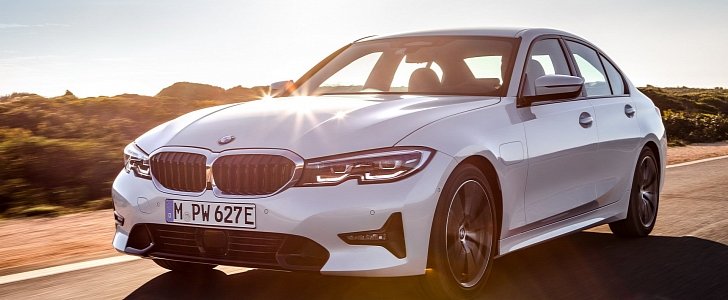The G20 3 Series family continues to grow by the day. After the recent reveal of the M340i, a performance powerhouse, the 330e puts a more eco-friendly spin on the sedan.
Plug-in hybrids are supposed to have the best of both worlds: the peace of mind of being able to drive emissions-free through a city and the flexibility of a combustion engine. While Tesla fans will say it's a waste to have two types of motors in a car, we think BMW did a good job.
The new 3 Series was designed from day one to have a plug-in version, so we expect the 330e to be better than its Mercedes-Benz rival. But let's dive into the specs. Horsepower? We have 184 HP from the usual 2-liter turbo unit, like the one in the 320i.
In addition to that, a small electric motor installed ahead of the gearbox provides an additional 68 HP. BMW claims that the e-motor is so cleverly integrated into the 8-speed ZF unit that it only adds 15mm of extra length under the hood.
However, under certain conditions, it can make as much as a 109 HP. Combined, they're supposed to offer 252 HP and 420 (309 lb-ft) normally or 292 HP for a few seconds of sprinting when Sports mode is engaged.
Thus, the 330e will go from 0 to 100 km/h in only six seconds and tops out at 230km/h (143mph).
For a plug-in hybrid, the range is more important than spirt times, but premium models are always expected to be juicier than your VW or Ford. In pure EV mode, the 330e will travel for up to 60 km (37 miles) before depleting its charge, and that's 50% more than before. That's thanks to a 12 kWh lithium battery mounted under the seats.
Also, a top speed of 140 km/h is possible without using the 2.0L. And as usual, the PHEV promises a ridiculous fuel economy figure: just 1.7 liters ever 100 kilometers. CO2 emissions stand at only 39 grams, which sounds like something European capitals can never ban.
The new 3 Series was designed from day one to have a plug-in version, so we expect the 330e to be better than its Mercedes-Benz rival. But let's dive into the specs. Horsepower? We have 184 HP from the usual 2-liter turbo unit, like the one in the 320i.
In addition to that, a small electric motor installed ahead of the gearbox provides an additional 68 HP. BMW claims that the e-motor is so cleverly integrated into the 8-speed ZF unit that it only adds 15mm of extra length under the hood.
However, under certain conditions, it can make as much as a 109 HP. Combined, they're supposed to offer 252 HP and 420 (309 lb-ft) normally or 292 HP for a few seconds of sprinting when Sports mode is engaged.
Thus, the 330e will go from 0 to 100 km/h in only six seconds and tops out at 230km/h (143mph).
For a plug-in hybrid, the range is more important than spirt times, but premium models are always expected to be juicier than your VW or Ford. In pure EV mode, the 330e will travel for up to 60 km (37 miles) before depleting its charge, and that's 50% more than before. That's thanks to a 12 kWh lithium battery mounted under the seats.
Also, a top speed of 140 km/h is possible without using the 2.0L. And as usual, the PHEV promises a ridiculous fuel economy figure: just 1.7 liters ever 100 kilometers. CO2 emissions stand at only 39 grams, which sounds like something European capitals can never ban.










